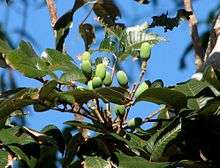Canarium australianum
Canarium australianum is a species of trees, native to Australia and Papua New Guinea, of the plant family Burseraceae.[1][2][3][4][5] Common names include mango bark, scrub turpentine, carrot wood, parsnip wood, Melville Island white beech and brown cudgerie.[1][3][4]
| Canarium australianum | |
|---|---|
 | |
| Scientific classification | |
| Kingdom: | Plantae |
| Clade: | Tracheophytes |
| Clade: | Angiosperms |
| Clade: | Eudicots |
| Clade: | Rosids |
| Order: | Sapindales |
| Family: | Burseraceae |
| Genus: | Canarium |
| Species: | C. australianum |
| Binomial name | |
| Canarium australianum | |
Three varieties are recognised in the Australian Plant Census:[1]
- C. australianum F.Muell. var. australianum
- C. australianum var. glabrum Leenh. — styptic tree, jalgir (Bardi language) — type specimen from Bickerton Island in the Gulf of Carpentaria
- C. australianum var. velutinum Hewson —jalgir (Bardi language) — type specimen from Cape Domett, north of Kununurra, Western Australia
In Australia trees of all three varieties grow naturally widespread across northern regions, from sea level up to about 500 m (1,600 ft) altitude. In particular, growing in the Kimberley region of Western Australia, the Arnhem Land region of the Northern Territory, in north-eastern Queensland in the Wet Tropics region, further southwards from there as far as about Airlie Beach and further north in Cape York Peninsula and the Torres Strait Islands.[3][4][5]
Full grown trees may grow up to about 20–30 m (70–100 ft) tall.[3][4][5]
References
- "Canarium australianum F.Muell". Australian Plant Name Index (APNI), IBIS database. Centre for Plant Biodiversity Research, Australian Government, Canberra. Retrieved 17 November 2013.
- "Canarium australianum". Germplasm Resources Information Network (GRIN). Agricultural Research Service (ARS), United States Department of Agriculture (USDA). Retrieved 20 July 2013.
- Hyland, B. P. M.; Whiffin, T.; Zich, F. A.; et al. (December 2010). "Factsheet – Canarium australianum var. australianum". Australian Tropical Rainforest Plants (6.1, online version RFK 6.1 ed.). Cairns, Australia: Commonwealth Scientific and Industrial Research Organisation (CSIRO), through its Division of Plant Industry; the Centre for Australian National Biodiversity Research; the Australian Tropical Herbarium, James Cook University. Retrieved 17 November 2013.
- Cooper, Wendy; Cooper, William T. (June 2004). "Canarium australianum F.Muell.". Fruits of the Australian Tropical Rainforest. Clifton Hill, Victoria, Australia: Nokomis Editions. p. 96. ISBN 9780958174213. Archived from the original on 9 April 2013. Retrieved 18 November 2013.
- Leenhouts, P. W.; Kalkman, C.; Lam, H. J. (March 1956). "Canarium australianum F.Muell.". Burseraceae (Digitised, online, via biodiversitylibrary.org). Flora Malesiana. Series I, Spermatophyta : Flowering Plants. 5. Leiden, The Netherlands: Rijksherbarium / Hortus Botanicus, Leiden University. pp. 284–285. Retrieved 7 December 2014.
External links
- Natural Assets Database: Canarium australianum
- "Canarium australianum F.Muell". Atlas of Living Australia.